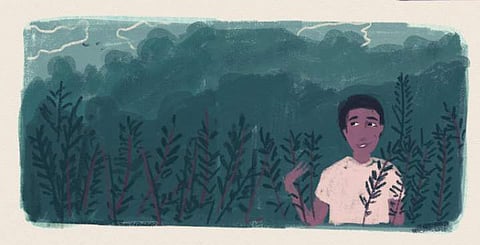

Salamanders, crickets and zebrafish is different from a lot of your usual comic strips. The characters here are not fictitious. Characters, businesses, places, events, locales, and incidents are not products of the imagination but are real. It also documents and illustrates the life of a section of people who are widely underrepresented in science - transgender people.
The first part of a comic series titled 'transgender persons in science' by a science collective The Life of Science, it illustrates the conversations between Bittu R, an evolutionary neuroscientist and a transman and a faculty of Ashoka University and science writer and communicator Sayantan Datta, who is also a neuroscientist in training. "As a science communicator, my goal is to always make my work as accessible to people as possible. Moreover, comics have a very broad appeal; illustration as a form of communication is very visual, lucid and captivating. I got a lot of encouragement from TheLifeofScience.com team, and I worked with illustrator Upasana Aggarwal to transform mine and Bittu's conversation into a comix about Bittu's life and science," says Sayantan, who is a queer trans person.
While Bittu and Sayantan are both alumni of the University of Hyderabad, the latter tells us how their timelines did not intersect. Bittu was also good friends with Rohith Vemula. This friendship too is mentioned in the comic strip. "I met Bittu when he came to Hyderabad for a few meetings that transgender people in Hyderabad were organising. Although distance separates us, Bittu is a really close friend and a mentor. Moreover, the number of transgender, gender non-conforming and gender non-binary people in STEM is very limited; the community (of trans, GNC and GNB people in STEM) is very small, so a lot of us know each other very well. We are also collectivising informally through WhatsApp groups to connect more trans, GNC and GNB people in academia to each other," says Sayantan.
The comic took a month to conceptualise after receiving a grant from DBT/Wellcome Trust India Alliance. The response to this, Sayantan says was surprising. "We were pleasantly surprised as to how well these comics were received. A lot of people got back to us about how the comix was not only informative but also inspirational. This also goes ahead to show the strength of multimedia as a form of communication," they say. "Comics are often easier to read and follow as compared with traditional text-based work, and also allow the creators and readers a very visual understanding of what's going on," they add.
Now, despite a fund crunch Sayantan says that they would like to take the series forward. In fact, in their second comic book, they have illustrated the life of Transgender activist Grace Banu. "While I would love to continue more work on similar lines, we are often constrained by the funding we receive and the time we have. However, I am hopeful that other science illustrators, writers and communicators will also take interest in this kind of work and we can all grow together towards a more inclusive representation of people in science," says Sayantan.
